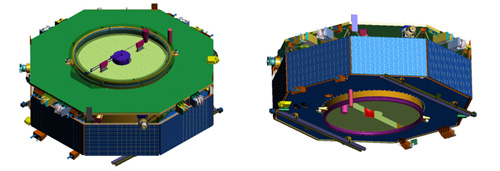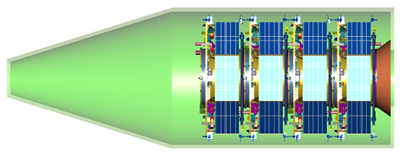MMS Spacecraft
The four MMS spacecraft are being developed at NASA's Goddard Space Flight Center,
which is also responsible for their integration and testing. Each spacecraft consists of an
eight-sided bus, roughly 11 feet across and 4 feet high, built around a central cylindrical
thrust tube. The majority of the instruments and associated electronics are mounted on the
underside of the octagonal top deck. The two magnetometer booms and one of the two
fly's eye energetic particle spectrometers (FEEPS) are mounted on the underside of the bottom deck; the second FEEPS is mounted on top of the top deck.
The two 12.5-meter Axial Double Probe booms are stored in the thrust tube and will be
deployed in the +Z and -Z directions once on orbit.

The MMS spacecraft viewed from above (left) and below (right). The double-probe and magnetometer booms are stowed.
Primary power is provided by eight
body-mounted solar array panels, with a secondary battery for energy storage. The
propulsion system consists of four hydrazine propellant tanks located within the thrust
tube and four axial and eight radial thrusters. The MMS spacecraft are spin-stabilized,
with a nominal spin rate of 3 rpm. Attitude knowledge is provided by 4 star cameras, 2
three-axis accelerometers, and 2 sun sensors, with the thrusters being used for attitude
and orbit adjustment maneuvers. A GPS receiver on board each spacecraft provides
absolute position information. In addition, each spacecraft employs an interspacecraft
ranging and alarm system (IRAS) to determine its location relative to the other three
spacecraft.

The four MMS spacecraft will be launched in a stacked configuration on a single launch vehicle and inserted sequentially into orbit.
|